How to Introduce a Cat to Water and Bathing
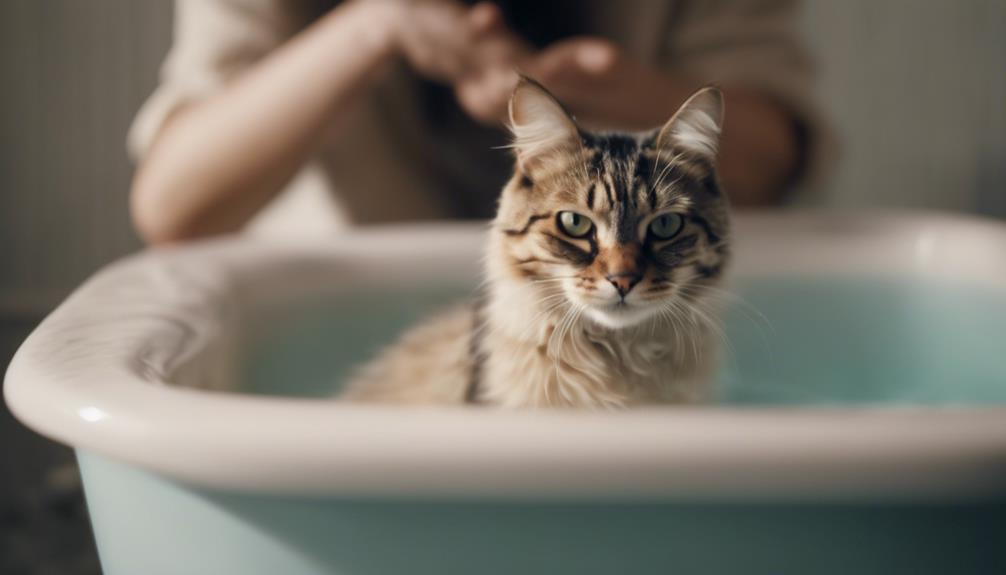
Introducing a cat to water and bathing can be a challenging task, but with patience and the right approach, it can become a stress-free experience. One tip is to start slowly by getting your cat accustomed to the sound of running water. You can do this by turning on a faucet or shower and letting your cat explore the area while the water is running.
Another tip is to use positive reinforcement during bath time. Offer treats and praise to help your cat associate bath time with something positive. It's also important to use lukewarm water and a gentle cat-friendly shampoo to make the experience more comfortable for your feline friend.
Remember to stay calm and patient throughout the process, as cats can pick up on your emotions. If your cat is particularly resistant to water, you can also try using a damp washcloth or specially designed cat wipes as an alternative to a full bath.
By following these tips and taking the time to gradually introduce your cat to water and bathing, you can help make the experience less stressful for both you and your furry companion.
Understanding Your Cat's Behavior
When observing your cat's behavior, it's important to pay attention to their body language and vocalizations to understand their feelings towards water and bathing. Cats communicate a lot through their body language. A cat that's fearful of water may exhibit behaviors like flattening their ears against their head, dilated pupils, a tense body posture, hissing, or swatting when near water. These signs indicate a feline fear response to the presence of water. Vocalizations can also provide clues about your cat's feelings toward water. If your cat meows loudly, growls, or expresses distress sounds when water is nearby, it's likely that they're anxious or scared.
Understanding your cat's body language and vocal cues is crucial in gauging their comfort level with water and bathing. By recognizing these signals, you can tailor your approach to gradually introduce them to water in a way that minimizes stress and anxiety. Patience and positive reinforcement are key when helping your cat overcome any fears they may have related to water and bathing.
Gradual Exposure to Water
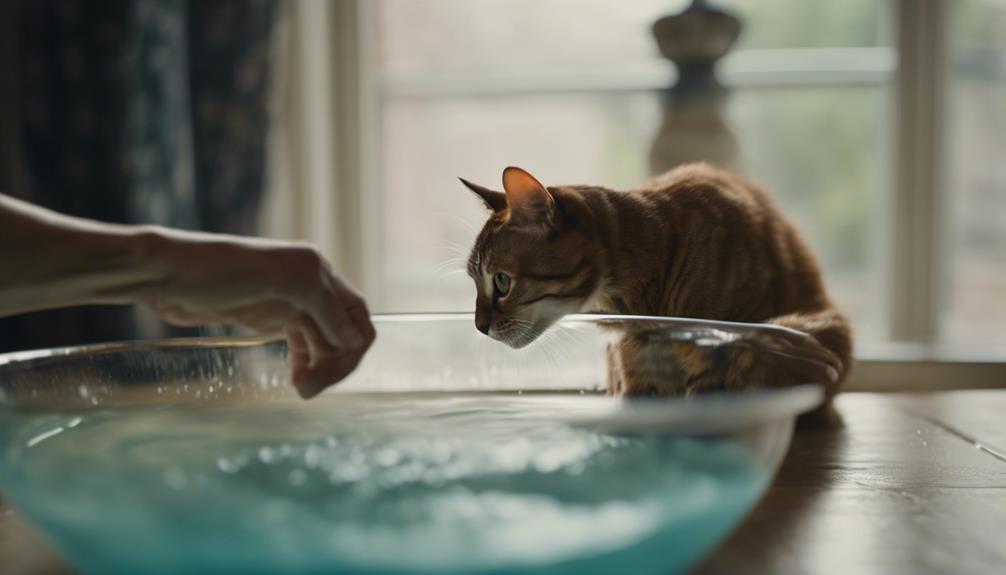
Gradually introducing a cat to water involves patience, positive reinforcement, and a step-by-step approach to minimize stress and anxiety for the feline. Here are some key steps to help acclimate your cat to water gradually:
- Slow Introduction: Begin by placing shallow bowls of water around the house for your cat to investigate at their own pace. This helps them get comfortable with the presence of water.
- Use Positive Reinforcement: Reward your cat with treats or affection when they show curiosity or calm behavior around water. This positive association encourages them to view water in a more favorable light.
- Water Play: Introduce interactive water toys or fountains to make water more engaging for your cat. Engaging in play can help your cat associate water with fun and enjoyment.
- Bonding: Incorporate water-related activities into your bonding time with your cat. This could include gentle petting near a running tap or incorporating water into grooming sessions to strengthen the bond between you and your feline companion.
Choosing the Right Bathing Products
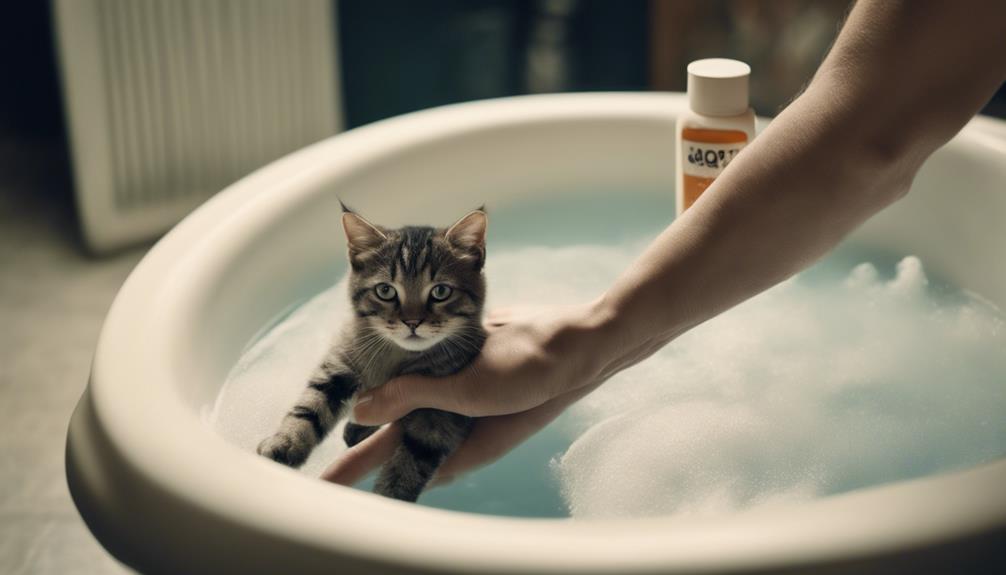
To ensure a cat's bathing experience is comfortable and effective, selecting the appropriate bathing products is crucial for maintaining their skin and coat health. When choosing bathing products for your feline friend, opt for specially formulated cat shampoos that are gentle on their skin and pH-balanced to prevent irritation. It's essential to avoid using human shampoos, as they can be too harsh for a cat's delicate skin.
Consider the following factors when selecting bathing products for your cat:
| Product Type | Benefits | Considerations |
|---|---|---|
| Cat Shampoo | Gentle on skin, pH-balanced | Avoid strong fragrances |
| Conditioner | Softens fur, reduces tangles | Check for safe ingredients |
| Brush | Helps distribute natural oils | Choose a brush suitable for cats |
| Towels | Absorbent, quick-drying | Use soft towels to avoid scratching |
Creating a Calm Bathing Environment
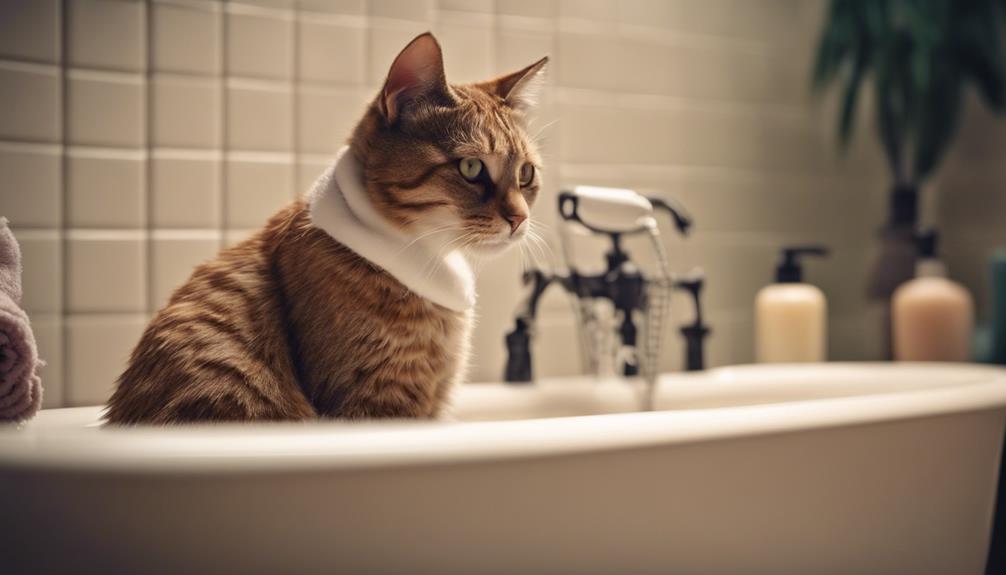
To create a calm bathing environment for a cat, gentle lighting can help promote relaxation, while playing soft music can contribute to a sense of calmness. These elements can be instrumental in soothing the cat and making the bathing experience more pleasant for both the feline and the owner.
Implementing these simple strategies can significantly reduce stress and anxiety during bath time.
Gentle Lighting for Relaxation
Soft, ambient lighting can significantly contribute to creating a calm bathing environment for your cat. When preparing the bathing area, consider the following:
- Dimmable Lights: Adjust the brightness to a soft, gentle level to avoid overwhelming your cat's senses.
- Warm Tones: Opt for warm-colored bulbs to create a cozy and inviting atmosphere.
- Natural Light: If possible, utilize natural light sources for a soothing effect during the bathing process.
- Subtle Night Lights: Consider adding a soothing night light near the bathing area to provide a sense of security and comfort for your cat.
These lighting choices can help foster a relaxing environment that promotes a positive bathing experience for your feline companion.
Soft Music for Calmness
Utilizing soft music can significantly enhance the calming atmosphere during your cat's bathing experience, promoting relaxation and reducing stress levels. Playing calming tunes can help distract your cat from the unfamiliar sensation of water, making the bathing process smoother. Consider playing classical music or nature sounds at a low volume to create a serene environment. It's essential to ensure the water temperature is lukewarm, around 100°F, to prevent any shock to your cat's system. Additionally, maintaining a consistent bathing frequency, typically every 4-6 weeks, can help your cat become more accustomed to water and reduce anxiety over time. By incorporating soft music, appropriate water temperature, and a consistent bathing schedule, you can create a peaceful bathing experience for your feline friend.
| Water Temperature | Bathing Frequency |
|---|---|
| Lukewarm (100°F) | Every 4-6 weeks |
Positive Reinforcement Techniques
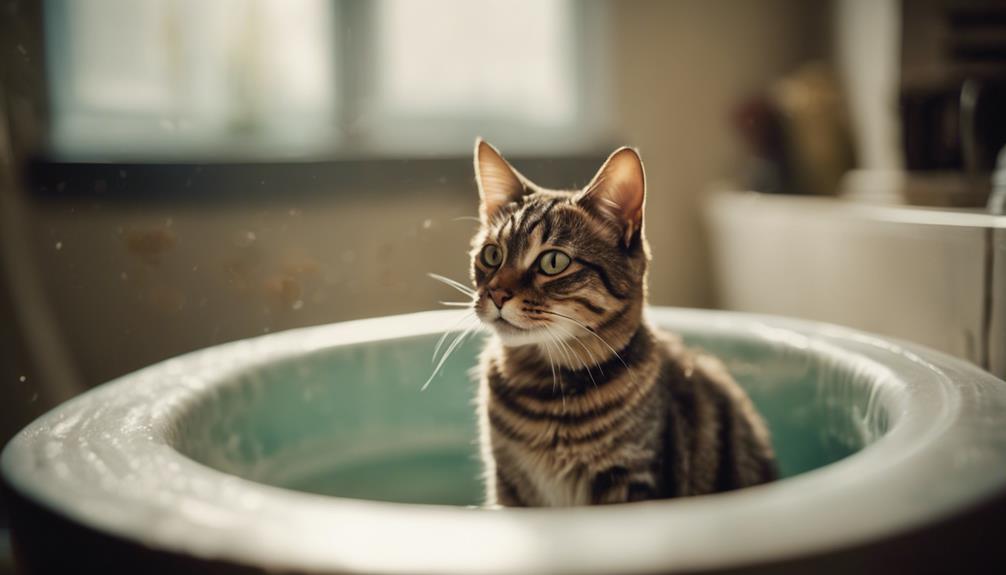
When introducing a cat to water and bathing, it's crucial to employ positive reinforcement techniques. Rewarding good behavior, using treats effectively, and offering consistent praise and rewards can help create a positive association with water-related activities.
These techniques can make the process smoother and less stressful for both the cat and the owner.
Rewarding Good Behavior
To encourage positive behavior in your cat, consider utilizing a system of rewards to reinforce desired actions during the introduction to water and bathing process. Positive reinforcement techniques can be effective in helping your cat associate water and bathing with positive experiences. Here are some tips for rewarding good behavior:
- Use verbal praise: Encourage your cat with a soothing voice to create a positive association with water.
- Offer treats: Reward your cat with small, tasty treats after a successful interaction with water to reinforce the behavior.
- Provide playtime: Engage your cat in a favorite game or activity as a reward for cooperating during the bathing process.
- Use gentle petting: Show affection through gentle strokes or pets to reassure your cat and reinforce calm behavior.
Using Treats Effectively
Encouraging positive behavior in cats during the introduction to water and bathing can be effectively achieved by utilizing treats as a form of positive reinforcement. Treat training involves offering small, tasty treats to your cat before, during, and after the bathing process. Positive reinforcement with treats can help your cat associate water and bathing with something pleasant, making the experience less stressful.
When starting treat training, it's essential to use high-value treats that your cat loves, such as pieces of cooked chicken or fish. By consistently rewarding your cat with treats for calm behavior and small milestones during the bathing process, you can build a positive association with water and grooming. Positive reinforcement through treats can help create a more cooperative and relaxed bathing experience for your feline friend.
Consistent Praise and Rewards
Utilizing consistent praise and rewards is an effective positive reinforcement technique in encouraging desirable behavior in cats during the introduction to water and bathing. Establishing a routine that includes positive association with water activities is key to helping your feline friend feel comfortable and safe during baths.
Here are some tips for incorporating consistent praise and rewards into your cat's bathing routine:
- Regularly praise your cat with a gentle voice and petting during water exposure sessions.
- Offer treats or a favorite toy after each successful interaction with water to create a positive association.
- Maintain a calm demeanor to reassure your cat and show that bath time is a pleasant experience.
- Consistency in rewarding good behavior will help your cat gradually become more accepting of water and bathing.
Handling and Drying Your Cat
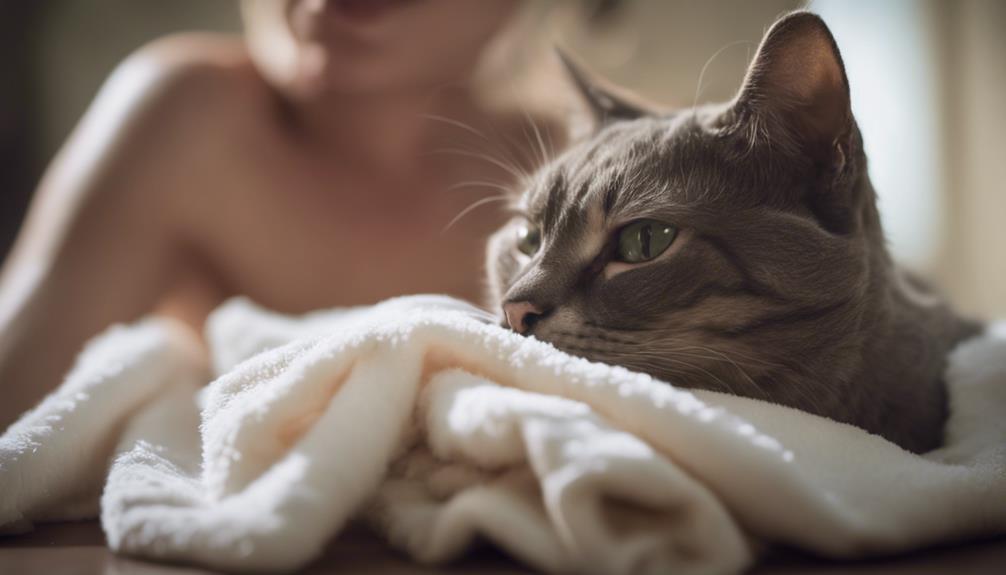
Gently supporting your cat's body while firmly securing their limbs can help ensure a safe and controlled bathing experience. When it comes to drying your cat after a bath, using a towel is the most common and effective method. Begin by gently wrapping your cat in a soft, absorbent towel. Pat your cat dry rather than rubbing vigorously to avoid causing distress. Make sure to use a separate, dry towel when drying your cat's face to prevent any irritation to their sensitive facial area.
After towel drying, you can proceed with grooming tips to help your cat feel comfortable and clean. Brushing your cat's fur can't only aid in drying but also prevent matting and tangling. Additionally, this grooming session can be a bonding experience for you and your cat. Pay attention to areas like under the chin and behind the ears, as these spots can retain moisture and lead to skin issues if left damp.
Troubleshooting Common Bathing Challenges
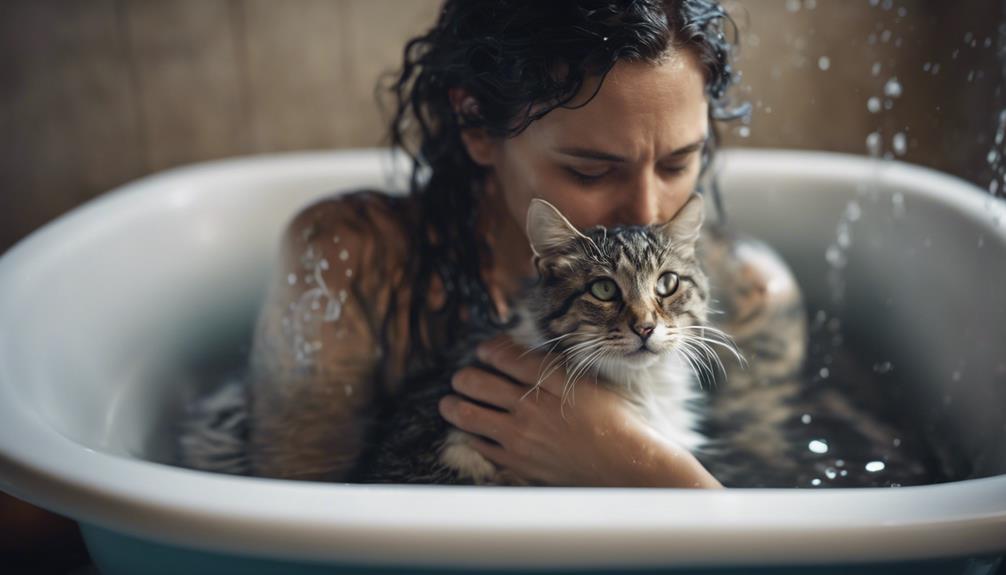
When faced with common bathing challenges, such as a resistant cat or excessive fur matting, it's essential to approach the situation with patience and strategic techniques. Cats may exhibit bathing resistance or fearful reactions, making the process challenging. To navigate these hurdles effectively, consider the following tips:
- Gradual Desensitization: Introduce your cat to water slowly, starting with just a damp cloth or sponge to get them used to the sensation before attempting a full bath.
- Positive Reinforcement: Reward your cat with treats or praise during and after the bathing process to create positive associations with water and bathing.
- Use Appropriate Products: Ensure you're using cat-friendly shampoos and conditioners to avoid skin irritation and make the bath more comfortable for your feline friend.
- Seek Professional Help: If your cat's bathing resistance or fearful reactions persist despite your best efforts, consult a veterinarian or professional groomer for guidance on how to approach the situation effectively.
Frequently Asked Questions
Can I Use Human Shampoo or Soap to Bathe My Cat?
When bathing a cat, it's important to use proper products designed specifically for cats. Human shampoo or soap can be harmful to a cat's skin due to different pH levels. Follow recommended bathing techniques to ensure a safe and effective grooming experience.
How Often Should I Bathe My Cat?
Cats should be bathed based on individual needs. Factors like hair matting and skin sensitivity determine bathing frequency. Some cats resist water, requiring less frequent baths. Regular grooming may reduce the need for bathing.
Are There Any Specific Water Temperature Guidelines for Bathing a Cat?
When bathing a cat, it is crucial to consider water temperature. Cats are sensitive to extreme temperatures. Lukewarm water around 100 degrees Fahrenheit is generally safe. Monitor the cat's behavior for signs of discomfort during the bath.
Should I Use a Towel or a Hairdryer to Dry My Cat After a Bath?
When drying a cat after a bath, using a towel is gentler and less stressful than a hairdryer. Grooming techniques involving towels are preferred for most cats. However, some cats may tolerate a hairdryer on a low, cool setting.
Is It Safe to Trim My Cat's Nails Before Bathing Them?
Trimming a cat's nails before bathing can be safe if done correctly. Proper nail trimming techniques can reduce the risk of scratches during bathing. It's important to ensure the cat is comfortable and calm before attempting nail trimming.











